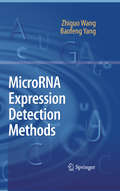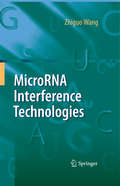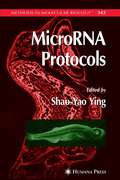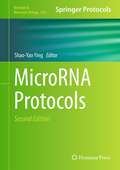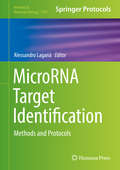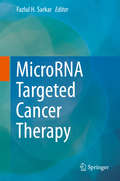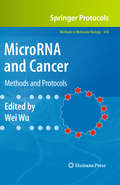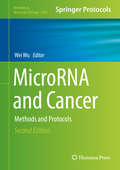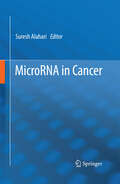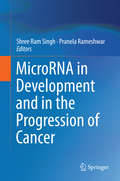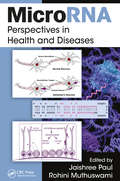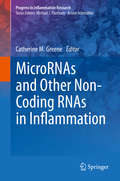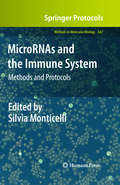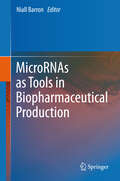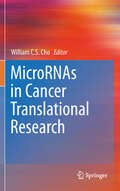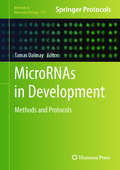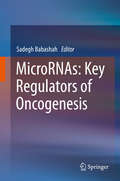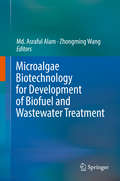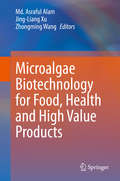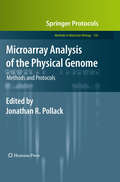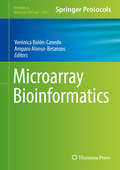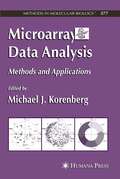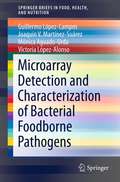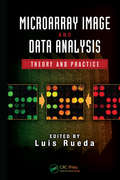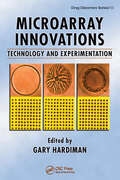- Table View
- List View
MicroRNA Expression Detection Methods
by Zhiguo Wang Baofeng YangThis book provides comprehensive descriptions of the innovative strategies and methodologies for detecting miRNA expression, their application in miRNA research and their potential as tools for clinical diagnosis and prognosis. It begins with the introduction of the overall concept and strategies of miRNA expression detection methods emphasizing the need of a wide variety of these methods to suit specific requirements for research and clinical examination in laboratories. In the following, each single chapter focuses on an independent, unique method of miRNA detection and is divided into five subsections: summary, introduction, protocol (including materials, instrument, reagent, and procedure), application and limitation, and reference. The development of the technique, the ideas behind it and the mechanisms underlying the method are given in the introduction of each chapter. The step-by-step protocols are detailed in the protocol section. Then, the applications and limitations of the methods are discussed. Finally, the literature citations are listed in reference section. Schematic diagrams are included where needed and appropriate for better illustrating the principle of the methodologies. In addition, flowcharts are also provided to outline the protocols for each of the miRNA expression detection methods. This book is aimed to target both researchers involved in miRNA research of any fields in universities and research institutions and medical practitioners who are interested in developing or utilizing miRNA profiling as a complementary and an alternative strategy for clinical diagnosis of human disease.
MicroRNA Interference Technologies
by Zhiguo WangMicroRNAs (miRNAs), endogenous noncoding regulatory mRNAs of around 22-nucleotides long, have rapidly emerged as one of the key governors of the gene expression regulatory program in cells of varying species, with ever-increasing implications in the control of the fundamental biological processes and in the pathogenesis of adult humans. The exciting findings in this field have inspired us with a premise and a promise that miRNAs will ultimately be taken to the heart for therapy of human disease. While miRNAs have been considered potential therapeutic targets for disease treatment, it remains obscured what strategies we can use to achieve the goal. In the past years, we have witnessed a rapid evolving of many creative, innovative, inventive strategies and methodologies pertinent to miRNA research and applications. These technologies have convincingly demonstrated their efficacy and reliability in producing gain-of-function or loss-of-function of miRNAs through targeting miRNA expression/biogenesis/function, providing new tools for elucidating miRNA functions and opening up a new avenue for the development of new agents targeting miRNAs for therapeutic aims. The present book provides comprehensive descriptions of these technologies and their applications to miRNA research and to new drug design for miRNA-related diseases. It starts with an overview of up-to-date knowledge of miRNA biology and the potential of miRNAs as therapeutic targets for human disease, followed by an introduction of the new concept of miRNA interference (miRNAi) and the perspectives of miRNAi technologies in general terms. In the following, each chapter introduces one of the miRNAi technologies with detailed descriptions of state-of-the-art design, procedures, principles and applications to basic research, R and D and clinical therapy.
MicroRNA Protocols
by Shao-Yao YingMicroRNA Protocols provides diverse, novel, and useful descriptions of miRNAs in several species, including plants, worms, flies, fish, chicks, mice, and humans. These include some useful adaptations and applications that could be relevant to the wider research community who are already familiar with the identification of miRNAs. This volume will stimulate the reader to explore diverse ways to understanding the mechanism in which miRNAs facilitate the molecular aspects of the biomedical research.
MicroRNA Protocols, Second Edition
by Shao-Yao YingExtensive studies have been conducted on the identification, biogenesis, and processing of microRNA (miRNA) as well as research on the exact mechanism by which miRNAs bring about translational silencing of their targets. In addition, numerous publications point to an important role of miRNAs in development, reprogramming, epigenetics, pathogenesis of cancer, oncogenes and tumor suppressors, biomarkers of various disease onset, and regulation of adipogenesis and obesity; yet many questions still remain. In MicroRNA Protocols, Second Edition, experts in the field provide up-to-date coverage of this diverse area of study. The specific chapters of this edition are related to the analysis of miRNA, targets and expression profiling, various methods to determine its regulation of gene expression, the preparation and isolation of miRNAs in specific tissues, its detection in the saliva, and potential application in cosmetics, wound healing, and prostate cancer. Written in the highly successful Methods in Molecular Biology™ series format, chapters include introductions to their respective topics, lists of the necessary materials and reagents, step-by-step, readily reproducible laboratory protocols, and tips on troubleshooting and known pitfalls.<P><P> Fully updated and easy to use, MicroRNA Protocols, Second Edition aims to stimulate readers to explore diverse ways to understand the mechanisms in which miRNAs facilitate the molecular aspects of not only biomedical research but also a wide range of other research fields.
MicroRNA Target Identification: Methods and Protocols (Methods in Molecular Biology #1970)
by Alessandro LaganàThis detailed book provides a comprehensive state-of-the-art presentation of all aspects of miRNA target identification, from the prediction of miRNA binding sites on their target molecules to their experimental validation and downstream functional analysis. It also explores methodologies and tools for target prediction and related analysis, as well as tutorials on specific tasks, tools, and analysis pipelines. Written for the highly successful Methods in Molecular Biology series, chapters include introductions to their respective topics, lists of the necessary materials and reagents, step-by-step, readily reproducible laboratory protocols, and tips on troubleshooting and avoiding known pitfalls. Authoritative and practical, MicroRNA Target Identification: Methods and Protocols updates on basic and advanced concepts involving miRNA target identification and delivers an extremely useful guide to specific computational tasks and analysis in miRNA research.
MicroRNA Targeted Cancer Therapy
by Fazlul H. SarkarSince the discovery of microRNAs (miRNAs) some twenty years ago by Victor Ambros, David Baulcombe and Gary Ruvkun, these three scientists worked to uncover the mystery of miRNA, the small segments of nucleotides that silence genes. While studying the development of the nematode worm, Ambros and Ruvkun discovered miRNA in animals, while Baulcombe discovered it in plants. Since their discovery, it took more than two decade to fully appreciate the value of miRNA in human health and diseases. Emerging evidence suggest that the activation of oncogenes and/or the inactivation of tumor suppressor genes contribute to the development and progression of tumors. The regulation of genes is by far controlled by many transcription factors which are often deregulated during the development and progression of cancer. In addition, emerging evidence clearly suggests that the deregulation of miRNAs or small non-coding RNAs could also regulate the expression of genes and likewise, miRNA genes are also regulated by transcription factors. The most attractive feature of miRNAs is that one miRNA can regulate many target genes (mRNAs) and thus miRNA targeted therapy is highly promising because multiple genes could be regulated by targeting a single miRNA, which becomes very important for the killing of highly heterogeneous populations of cancer cells within a tumor mass. Therefore, miRNA targeted therapy is an attractive attribute of miRNA research, which is covered through eighteen chapters complied in this book "MicroRNA targeted Cancer therapy" and it is hoped that the field of miRNA research will be appreciated through critical reading of these chapters on the cutting-edge research on miRNAs.
MicroRNA and Cancer
by Wei WuThe tiny microRNAs (miRNAs) can have huge impacts on the regulation of a variety of genes and play crucial roles in the fundamental cellular processes. Recent miRNA studies change the landscape of cancer genetics by scrutinizing the alterations of genome-wide miRNA expressions in most common cancers and their regulatory functions during the development of cancer. The connections between miRNAs and cancer are widespread enough to warrant more comprehensive investigations in the systems biology perspective. In MicroRNA and Cancer: Methods and Protocols, internationally renowned experts provide the latest miRNA knowledge, the various techniques and methodologies currently available for cancer research application. Ranging from the fundamental concepts to practical applications, this book presents: * Overview of microRNA biogenesis, computational prediction of new miRNAs in the cancer genome, and miRNA-based therapeutic approaches for cancer treatment * Detailed experimental protocols in miRNA detection with novel and high-throughput technology, miRNA library cloning, miRNA epigenetic regulation, and miRNA pathway study * Stepwise computational and bioinformatic procedures for miRNA complex networks in cancer genomes with a variety of softwares and programs * Cross-cited notes on troubleshooting and avoiding known pitfalls Authoritative and cutting-edge, MicroRNA and Cancer: Methods and Protocols serves researchers with the basic principles of experimental and computational methods for microRNA study in cancer research and provides a firm grounding for those who wish to further develop their own applications and tailor them to their own specific research needs.
MicroRNA and Cancer
by Wei WuThe tiny microRNAs (miRNAs) can have huge impacts on the regulation of a variety of genes and play crucial roles in the fundamental cellular processes. Recent miRNA studies change the landscape of cancer genetics by scrutinizing the alterations of genome-wide miRNA expressions in most common cancers and their regulatory functions during the development of cancer. The connections between miRNAs and cancer are widespread enough to warrant more comprehensive investigations in the systems biology perspective. In MicroRNA and Cancer: Methods and Protocols, internationally renowned experts provide the latest miRNA knowledge, the various techniques and methodologies currently available for cancer research application. Ranging from the fundamental concepts to practical applications, this book presents:* Overview of microRNA biogenesis, computational prediction of new miRNAs in the cancer genome, and miRNA-based therapeutic approaches for cancer treatment* Detailed experimental protocols in miRNA detection with novel and high-throughput technology, miRNA library cloning, miRNA epigenetic regulation, and miRNA pathway study* Stepwise computational and bioinformatic procedures for miRNA complex networks in cancer genomes with a variety of softwares and programs* Cross-cited notes on troubleshooting and avoiding known pitfalls Authoritative and cutting-edge, MicroRNA and Cancer: Methods and Protocols serves researchers with the basic principles of experimental and computational methods for microRNA study in cancer research and provides a firm grounding for those who wish to further develop their own applications and tailor them to their own specific research needs.
MicroRNA in Cancer
by Suresh AlahariThe field of microRNA biology is really emerging in the last couple of years. Several investigators highlighted the importance of miRNAs in cancer. Although there is so much literature on microRNAs exist, a comprehensive book is still not available. Thus this book will be a great use to the scientists in the field of cancer biology. In addition, this book will be a good source of information for undergraduate, graduate students who want to develop their research careers in cancer biology.
MicroRNA in Development and in the Progression of Cancer
by Shree Ram Singh Pranela RameshwarmiRNAs are a class of endogenous, small non-protein coding RNA molecules (~ 22 nucleotides) which are novel post-transcriptional regulators of gene expression Since we have hundreds of miRNAs, the major challenge is now to understand their specific biological function. In fact the experimental evidence suggests that signaling pathways could be ideal candidates for miRNA-mediated regulation. Several studies suggest that miRNAs affect the responsiveness of cells to signaling molecules such as WNT, Notch, TGF-β and EGFR Altered expression of particular miRNAs has been implicated in the onset and development of cancer and could be used as potential biomarkers for the disease. Recently, many studies have found miRNAs have crucial regulatory roles in Cancer stem cells (CSCs) a kind of tumor initiating cells (TICs) and dormancy. Findings also suggest that DNA methylation may be important in regulating the expression of many miRNAs in several cancer initiating cells. Several miRNAs are known to either upregulated or downregulated in CSCs when compared to non-cancerous cells from the same tissues. CSCs are a small subpopulation of cells identified in a variety of tumors and involve in self-renewal, differentiation, chemoresistance and tumorigenesis. The volume will give a comprehensive account of important advancements in the area of miRNAs and cancer.
MicroRNA: Perspectives in Health and Diseases
by Jaishree Paul Rohini MuthuswamiThis book explores the role of miRNA as therapeutic agents, the progress made in this direction and the problems that need to be addressed for miRNA based therapies to become successful. It also discusses the basic biology of miRNA sythesis, regulation, and their role in disease biology.
MicroRNAs and Other Non-Coding RNAs in Inflammation
by Catherine M. GreeneThe book serves as a comprehensive resource for scientists and clinicians studying the role of non-coding RNAs in inflammation (viral infections, wound inflammation), human inflammatory diseases (i. e. rheumatoid arthritis, Crohn's disease, diabetes) and innate immunity. It provides a universal reference work comprising both basic and specialized information. Given that ncRNAs represent new therapeutic targets, this volume will also be of interest to industrial biomedical researchers and those involved in drug development.
MicroRNAs and the Immune System
by Silvia MonticelliIn recent years, the critical role of microRNAs has been revealed within the biology of cells that constitute the immune system. In MicroRNAs and the Immune System: Methods and Protocols, expert researchers explore the latest techniques for studying miRNA expression, including the most up-to-date data on splinted ligation and qRT-PCR assays, as well as high-throughput profiling through cloning, deep sequencing, and microarrays. Chapters outline methods to study miRNA functions in various cell types from a single cell type level to entire model organisms, and present studies of miRNAs in the context of viruses and the immune response. Tools are also provided to help navigate bioinformatics databases on miRNAs and their targets. Composed in the highly successful Methods in Molecular BiologyTM series format, each chapter contains a brief introduction, step-by-step methods, a list of necessary materials, and a Notes section which shares tips on troubleshooting and avoiding known pitfalls. Contemporary and innovative, MicroRNAs and the Immune System: Methods and Protocols is an essential handbook for immunologists, biochemists, and molecular biologists.
MicroRNAs as Tools in Biopharmaceutical Production
by Niall BarronFocused manuscript on the potential use/role of miRNAs in bioprocessing, specifically the production of complex proteins in mammalian cells. With that in mind I propose a draft list of topics/chapters along the following lines: Intro on CHO/bioprocessing/engineering challenges to set scene, Genomic organization, biogenesis and mode of action, Identifying miRNA targets: Computational prediction, transcriptomics, proteomices, UTR analysis, etc., miRNA expression in Chinese Hamster Ovary cells, miRNAs as engineering targets: pathway manipulation to impact bioprocess phenotypes, miRNAs as biomarkers, Detection methods: Northern, PCR, hybridization arrays, Next Gen Seq, Manipulation of expression in cultured cells: Transient/stable disregulation, Knockout.
MicroRNAs in Cancer Translational Research
by William C.S. ChoMicroRNA (miRNA) is a cutting-edge topic in the scientific and medical fields. This is a timely and specialized book focusing on the current understanding of miRNAs and the potential for their application in cancer diagnosis, prognosis, and therapeutic targets. It also provides discussion of the lessons learned from translational miRNA studies and exploration of the next steps required to advance this field. The unique book comprises 22 in-depth chapters by gathering unparalleled topics of interest in miRNAs by international team of world-renowned experts in the field. The first fifteen chapters provide comprehensive and expert perspectives on the most common cancers from bench to bedside applications, there is no current book structured in this cancer-oriented way. The next seven chapters providing thorough overviews of miRNAs and cancer stem cells; miRNAs in cancer invasion and metastasis; miRNAs in predicting radiotherapy and chemotherapy response; as well as expounding the role of miRNA in anti-cancer drug resistance and as blood-based cancer biomarkers. Furthermore, this book explicates the interplay of miRNAs in cancer metabolism and an update on the pioneering RNAi-based treatment approaches is also presented. This specialized book will contribute great to the scientific and medical community by providing the up-to-date discoveries of miRNAs and their important roles in cancer translational research.
MicroRNAs in Development
by Tamas DalmaySince the discovery of microRNAs, developmental biologists have striven to understand the role of miRNAs in development and disease. MicroRNAs in Development: Methods and Protocols collects contributions from expert researchers in order to provide practical guidelines to this complex study. Divided into three convenient sections, this detailed volume covers various techniques to detect and profile miRNA expression, followed by protocols to manipulate the activity of miRNAs in various organisms, and it concludes with a section that outlines different methods to identify and validate miRNA targets in animals and plants. Written in the highly successful Methods in Molecular BiologyTM series format, chapters contain introductions to their respective topics, lists of the necessary materials and reagents, step-by-step, readily reproducible laboratory protocols, and notes on troubleshooting and avoiding known pitfalls. Authoritative and accessible, MicroRNAs in Development: Methods and Protocols serves as a practical guide for scientists of all backgrounds and conveys the appropriate sense of fascination associated with this vital field of research.
MicroRNAs: Key Regulators of Oncogenesis
by Sadegh BabashahAberrant expression and function of microRNAs (miRNAs) in cancer have added a new layer of complexity to the understanding of development and progression of the disease state. It has been demonstrated that miRNAs have a crucial function in oncogenesis by regulating cell proliferation and apoptosis as oncogenes or tumor suppressors. The expression signatures of miRNAs provide exciting opportunities in the diagnosis, prognosis and therapy of cancer. Since miRNAs can function as either oncogenes or tumor suppressor genes in oncogenesis, the potential of using these small RNAs as therapeutic targets opens up new opportunities for cancer therapy by either inhibiting or augmenting their activity.
Microalgae Biotechnology for Development of Biofuel and Wastewater Treatment
by Md. Asraful Alam Zhongming WangThis book addresses microalgae, which represent a very promising biomass resource for wastewater treatment and producing biofuels. Accordingly, microalgae are also an expanding sector in biofuels and wastewater treatment, as can be seen in several high-profile start-ups from around the globe, including Solix Biofuels, Craig Venter’s Synthetic Genomics, PetroSun, Chevron Corporation, ENN Group etc. In addition, a number of recent studies and patent applications have confirmed the value of modern microalgae for biofuels production and wastewater treatment systems. However, substantial inconsistencies have been observed in terms of system boundaries, scope, the cultivation of microalgae and oil extraction systems, production costs and economic viability, cost-lowering components, etc. Moreover, the downstream technologies and core principles involved in liquid fuel extraction from microalgae cells are still in their early stages, and not always adequate for industrial production. Accordingly, multilateral co-operation between universities, research institutes, governments, stakeholders and researchers is called for in order to make microalgae biofuels economical. Responding to this challenge, the book begins with a general introduction to microalgae and the algae industry, and subsequently discusses all major aspects of microalgal biotechnology, from strain isolation and robust strain development, to biofuel development, refinement and wastewater treatment.
Microalgae Biotechnology for Food, Health and High Value Products
by Md. Asraful Alam Zhongming Wang Jing-Liang Xu"Microalgae Biotechnology for Food, Health and High Value Products” presents the latest technological innovations in microalgae production, market status of algal biomass-based products, and future prospects for microalgal applications. It provides stimulating overviews from different perspectives of application that demonstrate how rapidly the commercial production of microalgae-based food, health and high value products is advancing. It also addresses a range of open questions and challenges in this field. The book highlights the latest advances of interest to those already working in the field, while providing a comprehensive overview for those readers just beginning to learn about the promise of microalgae as a sustainable source of both specialty and commercial products. It offers a valuable asset for commercial algae producers, algae product developers, scientific researchers and students who are dedicated to the advancement of microalgae biotechnology for applications in health, diet, nutrition, cosmetics, biomaterials etc.
Microarray Analysis of the Physical Genome
by Jonathan R. PollackIn the early years of microarray technology, efforts were directed mainly at profiling expressed genes, while recently the microarray platform has been adapted into diverse applications directed toward the investigation of the physical genome. In Microarray Analysis of the Physical Genome: Methods and Protocols, experts in the field cover DNA microarray applications for the detection and characterization of genomic DNA-associated copy number alteration, loss of heterozygosity (LOH), cytosine methylation, protein binding sites, regulatory elements, and replication timing, with an emphasis on higher eukaryote (animal) and cancer genomes. Written in the highly successful Methods in Molecular BiologyTM series format, chapters include a brief introduction to their respective subjects, lists of the necessary materials and reagents, step-by-step protocols, and time-saving notes on troubleshooting and avoiding known pitfalls. Authoritative and easy-to-use, Microarray Analysis of the Physical Genome: Methods and Protocols is of great value to the molecular biologist or computational biologist interested in understanding the principles of these analyses or in planning future experiments using microarrays to characterize the physical genome.
Microarray Bioinformatics (Methods in Molecular Biology #1986)
by Amparo Alonso-Betanzos Verónica Bolón-CanedoThis book provides a comprehensive, interdisciplinary collection of the main, up-to-date methods, tools, and techniques for microarray data analysis, covering the necessary steps for the acquisition of the data, its preprocessing, and its posterior analysis. Featuring perspectives from biology, computer science, and statistics, the volume explores machine learning methods such as clustering, feature selection, classification, data normalization, and missing value imputation, as well as the statistical analysis of the data and the most popular computer tools to analyze microarray data. Written for the highly successful Methods in Molecular Biology series, chapters include the kind of detailed implementation advice that will aid researchers in getting successful results. Cutting-edge and authoritative, Microarray Bioinformatics serves as an ideal guide for researchers and graduate students in bioinformatics, with basic knowledge in biology and computer science, and with a view to work with microarray datasets.
Microarray Data Analysis
by Michael J. KorenbergIn this new volume, renowned authors contribute fascinating, cutting-edge insights into microarray data analysis. Information on an array of topics is included in this innovative book including in-depth insights into presentations of genomic signal processing. Also detailed is the use of tiling arrays for large genomes analysis. The protocols follow the successful Methods in Molecular BiologyTM series format, offering step-by-step instructions, an introduction outlining the principles behind the technique, lists of the necessary equipment and reagents, and tips on troubleshooting and avoiding pitfalls.
Microarray Detection and Characterization of Bacterial Foodborne Pathogens
by Mónica Aguado-Urda Guillermo López-Campos Joaquín V. Martínez-Suárez Victoria López-AlonsoThis is a review of recent advances on the use of DNA microarray for diagnosing foodborne pathogens. Rapid detection and characterization of foodborne pathogens is critical for food safety. Many relevant technologies have been intensively developed to date. DNA microarray technology offers a new way to food safety involving pathogen detection and characterization. DNA microarray can be used for detection and characterization of pathogens by analyzing hybridization patterns between capture probes and nucleic acids isolated from food samples or bacteria. It allows more rapid, accurate, and cost-effective detection of pathogens compared with traditional approaches of cultivation or immuno-assays. The application of DNA microarrays to different foodborne bacteria, such as Campylobacter, Salmonella, Listeria monocytogenes, or Shiga toxin producing Escherichia coli, will improve their rapid identification and characterization of their genetic traits (e.g., antimicrobial resistance, virulence). As bacterial foodborne diseases are posing more serious threats to public healthcare, development of rapid and accurate methods for pathogen detection and characterization is critical to their proper control at the earliest time.
Microarray Image and Data Analysis: Theory and Practice (Digital Imaging and Computer Vision #8)
by Luis RuedaMicroarray Image and Data Analysis: Theory and Practice is a compilation of the latest and greatest microarray image and data analysis methods from the multidisciplinary international research community. Delivering a detailed discussion of the biological aspects and applications of microarrays, the book: Describes the key stages of image processing, gridding, segmentation, compression, quantification, and normalization Features cutting-edge approaches to clustering, biclustering, and the reconstruction of regulatory networks Covers different types of microarrays such as DNA, protein, tissue, and low- and high-density oligonucleotide arrays Examines the current state of various microarray technologies, including their availability and affordability Explains how data generated by microarray experiments are analyzed to obtain meaningful biological conclusions An essential reference for academia and industry, Microarray Image and Data Analysis: Theory and Practice provides readers with valuable tools and techniques that extend to a wide range of biological studies and microarray platforms.
Microarray Innovations: Technology and Experimentation
by Gary HardimanIn recent years, high-density DNA microarrays have revolutionized biomedical research and drug discovery efforts by the pharmaceutical industry. Their efficacy in identifying and prioritizing drug targets based on their ability to confirm a large number of gene expression measurements in parallel has become a key element in drug discovery. Microarr
